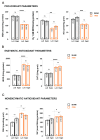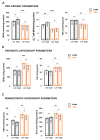Sustained Systemic Antioxidative Effects of Intermittent Theta Burst Stimulation beyond Neurodegeneration: Implications in Therapy in 6-Hydroxydopamine Model of Parkinson's Disease
- PMID: 38397816
- PMCID: PMC10885904
- DOI: 10.3390/antiox13020218
Sustained Systemic Antioxidative Effects of Intermittent Theta Burst Stimulation beyond Neurodegeneration: Implications in Therapy in 6-Hydroxydopamine Model of Parkinson's Disease
Abstract
Parkinson's disease (PD) is manifested by the progressive loss of dopaminergic neurons in the substantia nigra pars compacta (SNpc) and caudoputamen (Cp), leading to the development of motor and non-motor symptoms. The contribution of oxidative stress to the development and progression of PD is increasingly recognized. Experimental models show that strengthening antioxidant defenses and reducing pro-oxidant status may have beneficial effects on disease progression. In this study, the neuroprotective potential of intermittent theta burst stimulation (iTBS) is investigated in a 6-hydroxydopamine (6-OHDA)-induced PD model in rats seven days after intoxication which corresponds to the occurrence of first motor symptoms. Two-month-old male Wistar rats were unilaterally injected with 6-OHDA to mimic PD pathology and were subsequently divided into two groups to receive either iTBS or sham stimulation for 21 days. The main oxidative parameters were analyzed in the caudoputamen, substantia nigra pars compacta, and serum. iTBS treatment notably mitigated oxidative stress indicators, simultaneously increasing antioxidative parameters in the caudoputamen and substantia nigra pars compacta well after 6-OHDA-induced neurodegeneration process was over. Serum analysis confirmed the systemic effect of iTBS with a decrease in oxidative markers and an increase in antioxidants. Prolonged iTBS exerts a modulatory effect on oxidative/antioxidant parameters in the 6-OHDA-induced PD model, suggesting a potential neuroprotective benefit, even though at this specific time point 6-OHDA-induced oxidative status was unaltered. These results emphasize the need to further explore the mechanisms of iTBS and argue in favor of considering it as a therapeutic intervention in PD and related neurodegenerative diseases.
Keywords: 6-hydroxidopamine; Parkinson’s disease; intermittent theta burst stimulation; neuroprotection; oxidative stress; rTMS.
Conflict of interest statement
The authors declare no conflicts of interest.
Figures




Similar articles
-
Intermittent Theta Burst Stimulation Improves Motor and Behavioral Dysfunction through Modulation of NMDA Receptor Subunit Composition in Experimental Model of Parkinson's Disease.Cells. 2023 Jun 1;12(11):1525. doi: 10.3390/cells12111525. Cells. 2023. PMID: 37296646 Free PMC article.
-
Early Repetitive Transcranial Magnetic Stimulation Exerts Neuroprotective Effects and Improves Motor Functions in Hemiparkinsonian Rats.Neural Plast. 2021 Dec 27;2021:1763533. doi: 10.1155/2021/1763533. eCollection 2021. Neural Plast. 2021. PMID: 34987572 Free PMC article.
-
Functional Dopaminergic Neurons in Substantia Nigra are Required for Transcranial Magnetic Stimulation-Induced Motor Plasticity.Cereb Cortex. 2015 Jul;25(7):1806-14. doi: 10.1093/cercor/bht421. Epub 2014 Jan 22. Cereb Cortex. 2015. PMID: 24451657
-
The Natural Neuroprotective Compounds Used in the 6-Hydroxydopamine- Induced Parkinson's Disease in Zebrafish: The Current Applications and Perspectives.CNS Neurol Disord Drug Targets. 2023;22(10):1472-1483. doi: 10.2174/1871527322666221028152600. CNS Neurol Disord Drug Targets. 2023. PMID: 36306449 Review.
-
Effect of Theta Burst Stimulation-Patterned rTMS on Motor and Nonmotor Dysfunction of Parkinson's Disease: A Systematic Review and Metaanalysis.Front Neurol. 2022 Jan 12;12:762100. doi: 10.3389/fneur.2021.762100. eCollection 2021. Front Neurol. 2022. PMID: 35095722 Free PMC article.
Cited by
-
Cellular ROS and Antioxidants: Physiological and Pathological Role.Antioxidants (Basel). 2024 May 14;13(5):602. doi: 10.3390/antiox13050602. Antioxidants (Basel). 2024. PMID: 38790707 Free PMC article.
-
Parkinson's Disease: Bridging Gaps, Building Biomarkers, and Reimagining Clinical Translation.Cells. 2025 Jul 28;14(15):1161. doi: 10.3390/cells14151161. Cells. 2025. PMID: 40801594 Free PMC article. Review.
References
-
- Hernandez-Baltazar D., Zavala-Flores L.M., Villanueva-Olivo A. The 6-hydroxydopamine model and parkinsonian pathophysiology: Novel findings in an older model. El modelo de 6-hidroxidopamina y la fisiopatología parkinsoniana: Nuevos hallazgos en un viejo modelo. Neurologia. 2017;32:533–539. doi: 10.1016/j.nrl.2015.06.011. - DOI - PubMed
LinkOut - more resources
Full Text Sources
Miscellaneous

